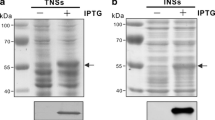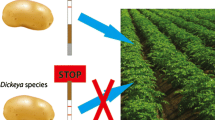Abstract
Pseudomonas syringae pv. actinidiae (Psa) is responsible for outbreaks of kiwifruit canker over the world, and the cause of heavy economic losses. Although molecular detection methods for this bacterium are well-established, its serological detection is much less advanced. A polyclonal antiserum to the bacterial effector-hopz5 was raised (PAb:hopz5) and its specificity tested. No cross-reaction was observed with other bacteria, including Pseudomonas syringae pv. tomato, Pseudomonas syringae pv. theae, Pseudomonas putida, Pseudomonas fluorescens, Pseudomonas koreensis, Bacillus subtilis, Bacillus megaterium, Ralstonia solanacearum, Erwinia rhapontica, Pseudomonas syringae pv. syringae. PAb:hopz5 was able to detect Psa from culture and infected plant samples, thus representing a suitable tool for the immunodetection of the agent of kiwifruit bacterial canker in field samples. The detection sensitivity of a colloidal gold immunochromatographic strip was high, up to 2.2 × 103 CFU/ml. Thus PAb:hopz5 constitutes a suitable and accurate tool for detection of Psa and haplotype distribution.








Similar content being viewed by others
References
Balestra GM, Taratufolo MC, Vinatzer BA, Mazzaglia A (2013) A multiplex PCR assay for detection of Pseudomonas syringae pv. actinidiae and differentiation of populations with different geographic origin. Plant Dis 97:472–478
Ballio A, Graniti A (1991) Phytotoxins and their involvement in plant disease. Experientia 47:751–755
Bereswill S, Bugert P, Volksch B, Ullrich M, Bender CL, Geider K (1994) Identification and relatedness of coronatine-producing Pseudomonas syringae pathovars by PCR analysis and sequence determination of the amplification products. Appl Environ Microbiol 60:2924–2930
Butler MI, Stockwell PA, Black MA, Day RC, Lamont IL, Poulter RTM (2013) Pseudomonas syringae pv. actinidiae from recent outbreaks of kiwifruit bacterial canker belong to different clones that originated in China. PLoS One 8:e57464
Chapman JR, Taylor RK, Weir MS et al (2012) Phylogenetic relationships among global populations of Pseudomoas syringae pv. actinidiae. Phytopathology 102:1034–1044
Ciarroni S, Gallipoli L, Taratufolo MC (2015) Development of a multiple loci variable of tandem repeats analysis (MLVA) to unravel the intra-pathovar structure of Pseudomonas syringae pv. actinidiae populations worldwide. PLoS One 10:2018–2025
Cimmino A, Iannaccone M, Petriccione M et al (2017) An ELISA method to identify the phytotoxic Pseudomonas syringae pv. actinidiae exopolysaccharides: a tool for rapid immunochemical detection of kiwifruit bacterial canker. Phytochem Lett 19:136–140
Everett K, Taylor R, Romberg M et al (2011) First report of Pseudomonas syringae pv. actinidiae causing kiwifruit bacterial canker in New Zealand. Aust Plant Dis Notes 6:67–71
Ferrante P, Takikawa Y, Scortichini M (2015) Pseudomonas syringae pv. actinidiae strains isolated from past and current epidemics to Actinidia spp. reveal a diverse population structure of the pathogen. Eur J Plant Pathol 142:677–689
Fujikawa T, Sawada H (2016) Genome analysis of the kiwifruit canker pathogen Pseudomonas syringae pv. actinidiae biovar 5. Sci Rep 6:21399
Gallelli A, L’Aurora A, Loreti S (2011) Gene sequence analysis for the molecular detection of Pseudomonas syringae pv. actinidiae: developing diagnostic protocols. J Plant Pathol 93:425–435
Gallelli A, Talocci S, Pilotti M, Loreti S (2014) Real-time and qualitative PCR for detecting Pseudomonas syringae pv. actinidiae isolates causing recent outbreaks of kiwifruit bacterial canker. Plant Pathol 63:264–276
Kim GH, Kim KH, Son KI et al (2016) Outbreak and spread of bacterial canker of kiwifruit caused by Pseudomonas syringae pv. actinidiae Biovar 3 in Korea. Plant Pathol J 32:545–551
Koh YJ, Nou IS (2002) DNA markers for identification of Pseudomonas syringae pv. actinidiae. Mol Cells 13:309
Koh YJ, Seo JK, Lee DH, Shin JS, Kim SH (1999) Chemical control of bacterial canker of kiwifruit. Plant Dis Agric Plants 5:95–99
Koh HS, Kim GH, Lee YS, Koh YJ, Jung JS (2014) Molecular characteristics of Pseudomonas syringae pv. actinidiae strains isolated in Korea and a multiplex PCR assay for haplotype differentiation. Plant Pathol J 30:96–101
Li X, Li P, Zhang Q, Li R et al (2013) Multi-component immunochromatographic assay for simultaneous detection of aflatoxin B1, ochratoxin a and zearalenone in agro-food. Biosens Bioelectron 49:426–432
Marques ASDA, Corbiere R, Gardan L et al (2000) Multiphasic approach for the identification of the different classification levels of Pseudomonas savastanoi pv. phaseolicola. Eur J Plant Pathol 106:715–734
McCann HC, Rikkerink EHA, Bertels F et al (2013) Genomic analysis of the kiwifruit pathogen Pseudomonas syringae pv. actinidiae provides insight into the origins of an emergent plant disease. PLoS Pathog 9:e1003503
Moon J, Kim G, Lee S (2012) A gold nanoparticle and aflatoxin B1-BSA conjugates based lateral flow assay method for the analysis of aflatoxin B1. Materials 5:634–643
Njukeng AP, Atiri GI, Hughes J, Winter S (2004) Development of serological procedures for rapid, sensitive and reliable detection of yam mosaic virus in yam tissues. Trop Sci 44:136–147
Rees-George J, Vanneste JL, Cornish DA et al (2010) Detection of Pseudomonas syringae pv. actinidiae using polymerase chain reaction (PCR) primers based on the 16S-23S rDNA inter-transcribed spacer region and comparison with PCR primers based on other gene regions. Plant Pathol 59:453–464
Ruinelli M, Schneeberger PHH, Ferrante P et al (2017) Comparative genomics-informed design of two LAMP detection assays for detection of the kiwifruit pathogen Pseudomonas syringae pv. actinidiae and discrimination of isolates belonging to the pandemic biovar 3. Plant Pathol 66:140–149
Scortichini M, Marcelletti S, Ferrante P, Petriccione M, Firrao G (2012) Pseudomonas syringae pv. actinidiae: a reemerging multi-faceted, pandemic pathogen. Mol Plant Pathol 13:631–640
Serizawa S, Ichikawa T, Takikawa Y, Tsuyumu S, Goto M (1989) Occurrence of bacterial canker of kiwifruit in Japan: description of symptoms, isolation of the pathogen and screening of bactericides. Jpn J Phytopathol 55:427–436
Takikawa Y, Serizawa S, Ichikawa T, Tsuyumu S, Goto M (1989) Pseudomonas syringae pv. actinidiae pv. Nov.: the causal bacterium of canker of kiwifruit in Japan. Ann Phytopathol Soc Jpn 55:437–444
Vanneste JL, Poliakoff F, Audusseau C et al (2011) First report of Pseudomonas syringae pv. actinidiae, the causal agent of bacterial canker of kiwifruit in France. Plant Dis 95:1311–1312
Vinatzer BA, Teitzel GM, Lee MW (2006) The type III effector repertoire of Pseudomonas syringae B728a and its role in survival and disease on host and non-host plants. Mol Microbiol 62:26–44
Wu WD, Li M, Chen M et al (2017) Development of a colloidal gold immunochromatographic strip for rapid detection of Streptococcus agalactiae in tilapia. Biosens Bioelectron 91:66–69
Xu T, Xu Q, Li G, Wang H, Li J, Shelver WL, Li J (2012) Strip-based immuno-assay for the simultaneous detection of the neonicotinoid insecticides imidacloprid and thiamethoxam in agricultural products. Talanta 101:85–90
Zhang C, Zhang Y, Wang S (2006) Development of multianalyte flow-through and lateral-flow assays using gold particles and horseradish peroxidase as tracers for the rapid determination of carbaryl and endosulfan in agricultural products. J Agric Food Chem 54:2502–2507
Zhou Y, Pan FG, Zhang YY et al (2009) Colloidal gold probe-based immunochromatographic assay for the rapid detection of brevetoxins in fishery product samples. Biosens Bioelectron 24:2744–2747
Acknowledgements
The study was financed by the project of science and technology ministry in Sichuan Province (2017NFP0115).
Author information
Authors and Affiliations
Corresponding author
Rights and permissions
About this article
Cite this article
Chen, H., Hu, Y., Qin, K. et al. A serological approach for the identification of the effector hopz5 of Pseudomonas syringae pv. actinidiae: a tool for the rapid immunodetection of kiwifruit bacterial canker. J Plant Pathol 100, 171–177 (2018). https://doi.org/10.1007/s42161-018-0041-y
Published:
Issue Date:
DOI: https://doi.org/10.1007/s42161-018-0041-y




